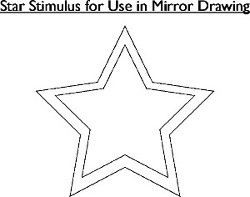Motor Learning in Mirror Drawing
Overview
Source: Laboratory of Jonathan Flombaum—Johns Hopkins University
Colloquially, the terms learning and memory encompass a broad range of behaviors and mental systems, everything from learning to tie a shoe to mastering calculus (and a lot in between). Experimental psychologists have divided up learning mechanisms into groups that seem to have different properties, and that seem to rely on different brain systems. A major division is between declarative and non-declarative memory, roughly, the sorts of things a person can express verbally—explicitly, like a birthdate, or what one ate for lunch—and things they cannot quite put into words—things they know implicitly, like how to get home despite not knowing the street names, or how to flip an omelet.
In the domain of non-declarative memory, a crucial kind of learning involves motor learning, sometimes also called procedural memory. Learning to drive a car is a good example. At first it is usually arduous and seems to involve explicit attempts to remember what to do next. Eventually it becomes second nature, though, something that a person just kind of knows how to do—and does better and better with time—but that can be hard to explain to someone else.
Mirror drawing is a common laboratory paradigm for investigating the acquisition of learned motor skills, the kind involved in driving, for example. This video demonstrates standard procedures for mirror drawing.
Procedure
1. Stimuli design
- This experiment requires a mirror that can stand on a table on its own, 2 ft by 2 ft (though larger is fine), as well as a flat rigid surface at least as big as an 8.5 x 11 in piece of paper, that can stand on its own while slightly tilted. A piece of wood with a stand or a piece of foam core is good. We will call this the occluder. The experiment also requires a pencil.
- Place the mirror about 12 in from the edge of a table, standing upright. Place the occluder so that it is about
Results
The results are graphed by plotting the number of errors in a session as a function of sequence (Figure 2). Note that performance improved over time. This is evidence of motor learning taking place. The strongest evidence is in the sessions following the long break. Here, the participant’s starting point is better than their starting point before the break. In other words, they retained what they learned, rather than forgetting it. Second, the rate of improvement—the slope of the curve—
Application and Summary
Mirror drawing has many applications for investigating the mechanisms of motor learning. For example, if a researcher wanted to investigate whether sleep supports motor learning, they might compare a group of participants who complete blocks of mirror drawing sessions, separated by a nap, with another group for whom the sessions are separated by a break without sleep. If the nap group showed fewer errors in the first session after the break than the no-nap group, it would suggest that napping promotes retention of recent
Skip to...
Videos from this collection:

Now Playing
Motor Learning in Mirror Drawing
Cognitive Psychology
55.3K Views

Dichotic Listening
Cognitive Psychology
26.3K Views

Measuring Reaction Time and Donders' Method of Subtraction
Cognitive Psychology
44.1K Views

Visual Search for Features and Conjunctions
Cognitive Psychology
26.8K Views

Perspectives on Cognitive Psychology
Cognitive Psychology
6.9K Views

Binocular Rivalry
Cognitive Psychology
7.8K Views

Multiple Object Tracking
Cognitive Psychology
7.6K Views

Approximate Number Sense Test
Cognitive Psychology
7.4K Views

Mental Rotation
Cognitive Psychology
13.0K Views

Prospect Theory
Cognitive Psychology
11.1K Views

Measuring Verbal Working Memory Span
Cognitive Psychology
12.4K Views

The Precision of Visual Working Memory with Delayed Estimation
Cognitive Psychology
5.1K Views

Verbal Priming
Cognitive Psychology
14.9K Views

Incidental Encoding
Cognitive Psychology
8.4K Views

Visual Statistical Learning
Cognitive Psychology
7.0K Views
Copyright © 2025 MyJoVE Corporation. All rights reserved
